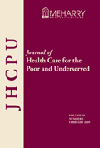In this profile, Kate Wilson, RN, Director of Health Information Services at Arlington (Va.) Free Clinic, describes the process of implementing an electronic medical records system in the clinic. Wilson represented ACU on a panel on rural and underserved patients during the Capitol Hill Steering Committee on Telehealth and Healthcare Informatics’ Technology Showcase.
Arlington Free Clinic (AFC) is a private, non-profit, volunteer-based clinic providing comprehensive healthcare services to uninsured residents of Arlington, Va. Recognizing the value of health information technology (IT), in 2005, AFC partnered with the Primary Care Coalition of Montgomery County, Md., to adopt CHLCare, a grant-funded, Web-based electronic medical record (EMR) system. The Primary Care Coalition made the system available to AFC as part of a regional expansion of CHLCare. It provided improved capture of demographic and aggregate health information about our patients, but was not a true patient-centered EMR.
We began to search for an alternative EMR and developed criteria by which to judge the various proprietary systems available. Cost was a significant issue for the clinic, but not the only area of concern for us. As a volunteer-based free clinic we needed:
- an intuitive system that would support more than 75 physicians and nurse practitioners and 160 clinical volunteers, many of whom will use the system as infrequently as once a month
- an effective appointment module to schedule both patients and providers
- a robust medication component
- a flexible template module to support primary care as well as more than 10 specialties
- a strong registry system for management of patients with chronic illnesses.
In summer 2009, we met with representatives of HealtheState, having heard of their EMR from a free clinic in West Virginia. HeS received a federal appropriation which allowed them to offer the system to AFC free-of-charge as a model safety-net clinic using HeS in Virginia. On Feb. 1, 2010, AFC went live with HeS.
The normal challenges to implementing an EMR are exacerbated for us by the number of volunteer providers using the system, the infrequency with which they come to clinic, and the need to raise the funds necessary to support the move to an EMR.
- Training is a huge task. Since January we have trained more than 240 individual users
- As a cost saving, we decided not to scan prior data into the system. Rather we enter essential data such as problem lists, medications, etc. into the patient record before the patient’s first EMR-based visit and provide the paper chart to the physician as reference.
- We significantly reduced the number of available patient visits to accommodate the increased time needed to complete a visit – a painful decision in the face of the number of individuals seeking health care at AFC each month.
- We actively sought and continue to seek funding through grant writing. We are presently waiting to hear about two pending technology grants totaling $330,000 over two years.
Some lessons learned
1. As obvious as it sounds, it is essential that the vendor understand as fully as possible the culture and environment of the organization that will be using their product and that the clinic staff clarify for themselves and for the vendor what they need and want from an EMR. Such clarity is not always easy to reach since the backgrounds of most free clinic staff are in health care and not in IT.
2. In the same vein, although many physicians, nurses and other healthcare providers use computers on a daily basis, most over the age of 30 are not natives in the IT world. As a result, they often feel that they are compromising patient care by having to focus on the computer. This can lead to discouragement and, in a volunteer-based organization, loss of service providers.
3. Funding Health IT involves much more than simply acquiring the system. Our costs included the purchase and upgrading of hardware, wireless and wired Internet access, ongoing technical support for our IT infrastructure and salary for a dedicated health information system staff member.
Some consequences of the clinic’s move to an EMR
1. AFC depends almost entirely on private donations. We receive no county or federal funding. A decrease in the amount of services we provide, due to implementation of an EMR, can significantly impact our ability to raise funds. We run the risk of losing funding as we struggle to return to our pre-implementation levels of service.
2. Provider discomfort with an electronic system has, to date, resulted in the loss of just two volunteer physicians. We listen carefully to providers concerns and try to address them as quickly as possible to support them and to prevent any further loss of volunteer providers.
The future
1. HeS’s EMR does not have an effective scheduling module. One of our pending grants, if awarded, will provide the $100,000 needed to develop one.
2. We need to build an interface with our pharmacy software.
3. And finally to be a truly effective electronic medical record, we need a health information exchange to link the hospital, the ER, the laboratory and referral physicians to the clinic. Despite the ongoing costs and the temporary decrease in services, AFC remains committed to improving patient care and patient care outcomes for the uninsured through the use of Health IT.
 Follow
Follow





Follow Us!